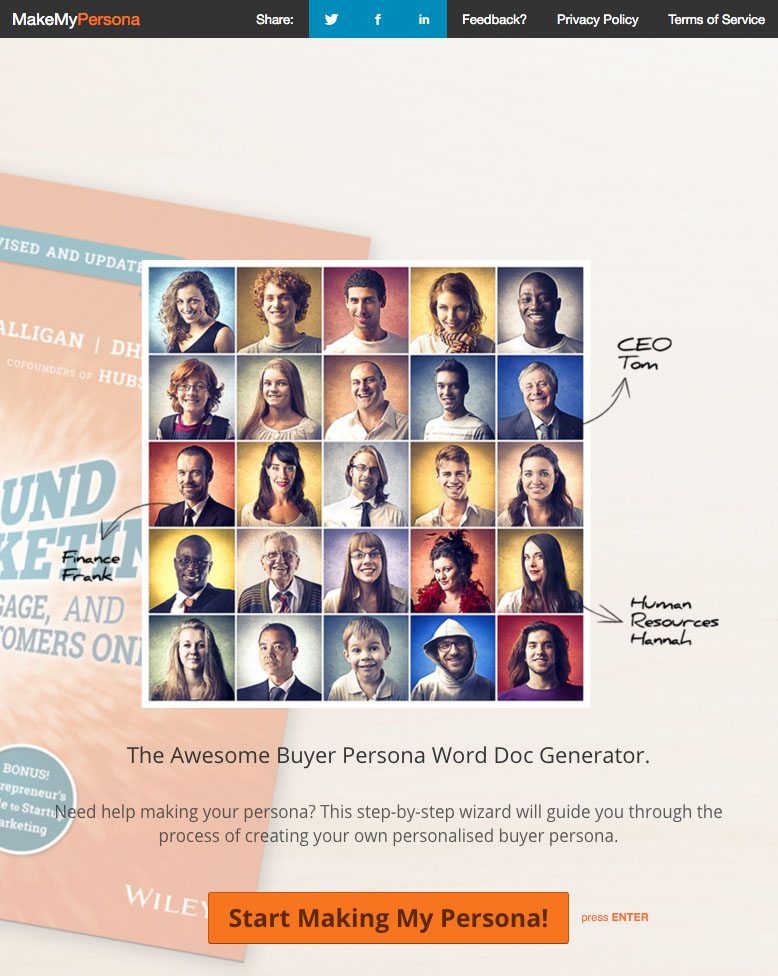An Introduction to Account Based Marketing (ABM)
Over the course of the past decade we’ve seen many changes take place in the world of marketing, both ‘real world’ and digital. SEO has evolved into...
If you're new to HubSpot, we guide you on where to start, how to do it right, and train you to make the most of the platform.
Review your HubSpot portal to uncover issues, spot growth opportunities, and ensure you're maximising its potential.
Unlock business growth with automation and attribution. Implement best practices and execute marketing campaigns.
HubSpot On-Demand
HubSpot Training
HubSpot Websites
HubSpot Campaigns
HubSpot Optimisation
7 min read
![]() Solar Trust Centre Team
5 April 2016 3:56:23 PM
Solar Trust Centre Team
5 April 2016 3:56:23 PM
If your current lead generation efforts are not delivering, you might not understand your customers as well as you thought. You may need to refine your buyer persona profiles. Leads and buyer personas are very important and useful in understanding the purchasing behaviour and other buying considerations of customers and potential buyers. Through personas, business organisations can understand how a prospect behaves when converting your lead persona to a buyer persona. One of the well-known advantages of this is the ability to shape lead and buyer personas to custom fit the needs of dedicated lead management, sales and nurturing teams.
A buyer persona represents a business’ ideal customer based on real data and market research about your existing customers. A detailed or comprehensive buyer persona can help you as a business or as a marketer to determine where you need to focus your time, what products to develop and how to align all of this with your marketing efforts. This will result in attracting the most valuable visitors, leads and customers to your brand or business. Also, when you have the insights into what your buyers think about doing business with you, including the exact words or quotes from people who have recently made purchasing decisions, you’ll have the knowledge you need to align your marketing strategies and decisions – from positioning and messaging through content marketing and enabling sales to meet the expectations of your buyers.
When creating forms to use on your blogsite or website, use form fields that capture the essential persona information. Say for example, if your personas are based on company size, ask each lead for information about the size of their company on your forms.
Buyer personas can be created through surveys, research and interviews. You can also do some social media research. Take advantage of “social media listening” to search your possible customers and ask them questions or provide solutions using Facebook, Twitter, Instagram, LinkedIn or Pinterest.
You can also utilise your contact database and your other online tools to identify trends and patterns in the way leads are consuming your content online.

Most importantly, talk to your sales team when creating your buyer personas because they are the ones that can tell you about common concerns, inquiries and pain points. Take the sales team’s feedback on the leads they are interacting with.
Usually, your buyer persona is a short, single page summary of one type of person within your specific target market. It is recommended that you make 3-5 personas to fully represent your audience.
Below is a quick overview of what you should include in your persona template:
1. Name of the Persona
2. Job Title
3. Demographics
4. Goals and Challenges
5. Values and Fears
6. The Marketing Message
7. The Pitch
Once you have a basic template you need to collect the information. As well as the main information points mentioned above, you could include some miscellaneous information that you consider relevant to your buyer personas. For instance you might ask about hobbies, the blogs they read or where they get their news and information on a daily basis.
Once you have all the information that you need, the next step is to build the profile.
1. Give the person a name. Any name that you can think of as long as it doesn’t offend anyone. Make it a real name so that the buyer persona will feel like a real person.
2. Give the person a job, a company and a role within the company. Customer surveys are the best source for coming up with jobs for your persona. Whenever you’re trying to build surveys, don’t forget to include a field for job title, type of business and company size.
3. Demographic information. For the demographics, you can get some insights from Google Analytics including your survey info and best guesses. Checking out Google Analytics statistics can show your site visitor’s age, gender, their affinity, town or state, and the technology they’re using when viewing your site. Just navigate to the Audience section of Google Analytics to see all information mentioned. Use survey results to build on this basic information.

Try HubSpot's Make My Persona tool.
4. Values, fears and goals. Interviewing actual customers will help you in fulfilling your objectives for this part. During your interview, ask questions similar to those below depending on the person and the industry they are in:
While coming up with solutions to these challenges, you can also identify the different ways you can help customers meet their goals. Your intuition can also help – try putting yourself in their situation and approach the fix with empathy. Take note of the common objections and fears that arise during the sales process.
5. The marketing message. Marketing message refers to how you describe your product for this specific buyer persona. From here you can pitch, go into detail and set a consistent marketing message to sell to the customer in that particular persona group.
Once you create these personas, explore, test and adopt a few ways to leverage the personas in your marketing strategy:
Once you get to this stage, you should have a clear vision of demographic information, issues faced, educational background, common objections and motivations of each audience segment that your buyer personas represent. Develop a unique or specific message that targets each persona you’ve created and then consistently apply it throughout the key marketing points like your social media channels, email campaigns and blog/website content.
Keep your buyer personas in mind when building your blogsite or website. Say for example, you have 3 buyer personas that need to take in different information before they are ready to purchase your brand, products or services. In this case, you may need to think of your website as having three divergent tracks. One persona may be interested in using your product in a different way than the other two. Your blog site should be tailored to all three personas. Provide content and messaging that reinforces the unique or specific pain points that each persona is experiencing. If blog posts feature as the primary content on your site, write articles that target and attract each of your buyer personas.
Email is one of the most effective tools in building and sustaining customer relationships. To connect with your buyer personas through email, you have to segment your distribution list based on the characteristics of each buyer persona and lay down the marketing message that focuses on each persona’s motivations and pain points. Use content personalisation where possible. Customers love to feel that they are being taken care of and the business or brand is reaching out to them in a very personal way. Include the recipient’s first name, their company name, job title and other information all throughout the email to check the personalisation impact.
Social media is a very powerful tool for many types of business these days. Just like blogging, your social posts should target each of your personas and should be engaging so that other people will be enticed to read or watch your posts. Don’t just post on your social media account for the sake of being active. A business social media account should be treated with a different strategy than your personal account.

Every buyer has a personal preference about how they like to purchase. Experts believe that there are 6 specific types of buying preferences or personalities to consider:
The decisive buyer is directive and this person loves to solve problems in an active and assertive manner. This person is results-driven and proactive and wants to get a great deal every time.
If you’re trying to sell to the decisive one, you should adopt the same characteristics. Demonstrate willingness and take some risks on your end which will help the buyer succeed. However, the buying process should feel organic for the decisive one. This person doesn’t like building consensus or forming a committee to make a decision.
The collaborative one is the opposite of the decisive one. The collaborative one likes solving problem with other people. This person is tactful, deliberative, diplomatic and adaptable. This person is very respectful of others. If you’re trying to sell to the collaborative one, consensus building is a plus to him or her. You have to work with this person to understand and include all the other purchasing influences. Discuss things with this person to draw out thoughts, inquiries and needs. Some things may take some time and you don’t need to be frustrated. The collaborative one likes to think and analyse things. This person will buy when ready and everyone agrees with the decision.
The social one likes social interaction and engaging with other people is essential to them. This person is a team player, a creative problem solver, enthusiastic and a builder of relationships. This person likes to see the big picture and is not shy to take some time for communication.
If you want to sell to this person, minimise the technical details. Listen to their ideas and match your own enthusiasm to theirs. This person will also weave between business talk and personal matters. Whenever you discuss a sale with this type of person, do not overdo the voice of reason because they are likely to lose interest.

This one is a reserved thinker and doesn’t say yes without knowing all the possibilities. It takes a while for this person to open up and develop trust with people, which can be very valuable to you if you put in the time and effort. The skeptic knows what they are and proud to deal out realism on the table. If you’re selling to a skeptic, email is one of the best communication avenues. Do not be turned off by the lack of feedback or positive gestures because they do tend to read your content or messages but are not likely to be demonstrative. You don’t have to be too personal or too friendly immediately because the skeptic will not respond in the way the social persona does. They may not share much in discussions or meetings, but you have to make sure that their needs are met because once they convert and become customers, they will be very loyal to the business or brand.
Established methods, proven information, valuable data, past and future success are all important to the analytical one. This person is cautious and does everything by the book and the established standards. This person is a comprehensive problem solver and often examines all the different angles before making an educated and researched decision. The skeptic and the analytical one go hand-in-hand in many situations.
In order to sell to the analytical one you need to provide data, information and reviews that will help them with their decision. Appropriate detail is essential. At some point, you may need to push back a bit because this person may sometimes leave the data door open longer than needed. If you push too hard before this person has completed his or her analysis, the deal may be off.
The innovator doesn’t care much for rules, procedures or how things were done in the past. They make their own rules and value their own ideas and strategies that are independent from established rules. The innovative one likes to solves problems in creative ways. This person tends to push the boundaries just to test them and see what happens. They are risk takers.
If you want to sell to the innovative one you have to procure their interest with new ideas or new ways of doing things. Brainstorming is one of the things they really like. Don’t shut down any creative discussions and keep moving forward because innovators can be disorganised sometimes. Show them how doing business with you will turn their bright ideas into reality.
Analysing your own customers and site visitors is the first step to understanding buyer personas and using them to improve your marketing efforts.
Over the course of the past decade we’ve seen many changes take place in the world of marketing, both ‘real world’ and digital. SEO has evolved into...
Business to business and inbound marketing are a surprisingly good fit. Many marketers in more traditionally sales-focused industries initially shy...
It’s thought that many organisations spend up to 90% of their marketing budgets on outbound marketing, despite the fact that it’s difficult to track...